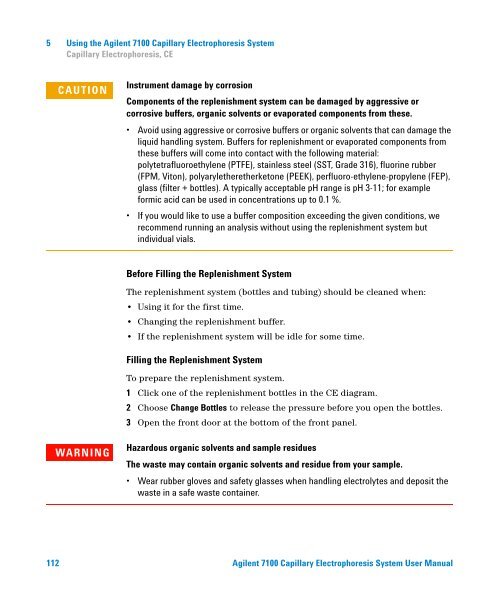Introduction to the Agilent 7100 Capillary Electrophoresis System
Introduction to the Agilent 7100 Capillary Electrophoresis System
Introduction to the Agilent 7100 Capillary Electrophoresis System
Create successful ePaper yourself
Turn your PDF publications into a flip-book with our unique Google optimized e-Paper software.
5 Using <strong>the</strong> <strong>Agilent</strong> <strong>7100</strong> <strong>Capillary</strong> <strong>Electrophoresis</strong> <strong>System</strong><br />
<strong>Capillary</strong> <strong>Electrophoresis</strong>, CE<br />
CAUTION<br />
Instrument damage by corrosion<br />
Components of <strong>the</strong> replenishment system can be damaged by aggressive or<br />
corrosive buffers, organic solvents or evaporated components from <strong>the</strong>se.<br />
• Avoid using aggressive or corrosive buffers or organic solvents that can damage <strong>the</strong><br />
liquid handling system. Buffers for replenishment or evaporated components from<br />
<strong>the</strong>se buffers will come in<strong>to</strong> contact with <strong>the</strong> following material:<br />
polytetrafluoroethylene (PTFE), stainless steel (SST, Grade 316), fluorine rubber<br />
(FPM, Vi<strong>to</strong>n), polyaryle<strong>the</strong>re<strong>the</strong>rke<strong>to</strong>ne (PEEK), perfluoro-ethylene-propylene (FEP),<br />
glass (filter + bottles). A typically acceptable pH range is pH 3-11; for example<br />
formic acid can be used in concentrations up <strong>to</strong> 0.1 %.<br />
• If you would like <strong>to</strong> use a buffer composition exceeding <strong>the</strong> given conditions, we<br />
recommend running an analysis without using <strong>the</strong> replenishment system but<br />
individual vials.<br />
Before Filling <strong>the</strong> Replenishment <strong>System</strong><br />
The replenishment system (bottles and tubing) should be cleaned when:<br />
• Using it for <strong>the</strong> first time.<br />
• Changing <strong>the</strong> replenishment buffer.<br />
• If <strong>the</strong> replenishment system will be idle for some time.<br />
Filling <strong>the</strong> Replenishment <strong>System</strong><br />
To prepare <strong>the</strong> replenishment system.<br />
1 Click one of <strong>the</strong> replenishment bottles in <strong>the</strong> CE diagram.<br />
2 Choose Change Bottles <strong>to</strong> release <strong>the</strong> pressure before you open <strong>the</strong> bottles.<br />
3 Open <strong>the</strong> front door at <strong>the</strong> bot<strong>to</strong>m of <strong>the</strong> front panel.<br />
WARNING<br />
Hazardous organic solvents and sample residues<br />
The waste may contain organic solvents and residue from your sample.<br />
• Wear rubber gloves and safety glasses when handling electrolytes and deposit <strong>the</strong><br />
waste in a safe waste container.<br />
112 <strong>Agilent</strong> <strong>7100</strong> <strong>Capillary</strong> <strong>Electrophoresis</strong> <strong>System</strong> User Manual
















